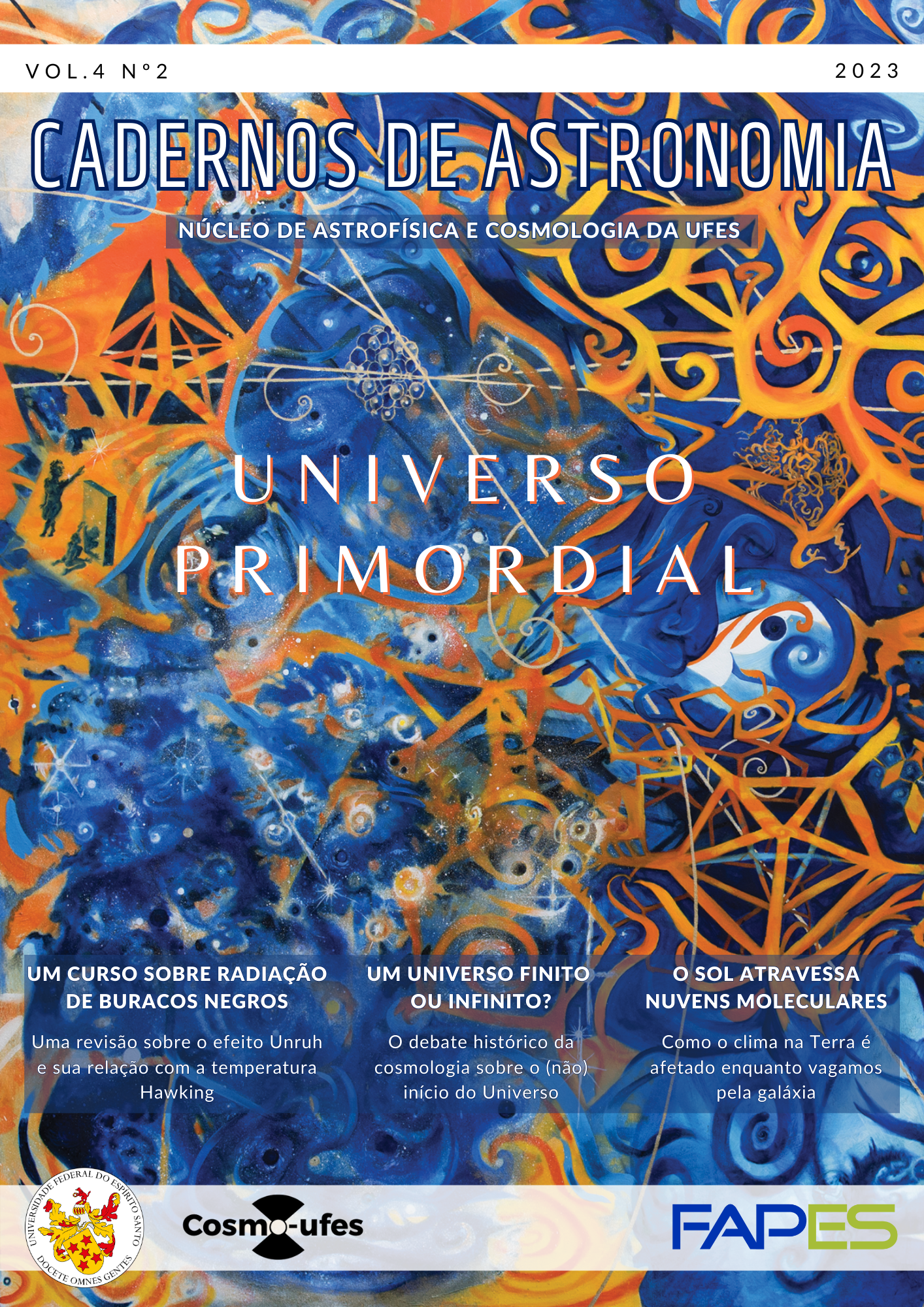Análise espectral da composição química do meteoro incidente no dia 02/01/2023
DOI:
https://doi.org/10.47456/Cad.Astro.v4n2.41689Palavras-chave:
Espectroscopia de Meteoros, Espectro, Composição QuímicaResumo
No Brasil, existe uma carência de pesquisa relacionada a espectroscopia de meteoros, por este motivo o trabalho desenvolvido pode ser considerado pioneiro. Para esta pesquisa, foi instalada uma estação de monitoramento em vídeo de meteoros, como as usadas pela BRAMON no âmbito do projeto PATRICIA, com uma rede de difração acoplada à câmera, de modo que a captura de um meteoro possa revelar o espectro do seu rastro. Para a captura foi usada uma câmera de vigilância Samsung modelo SCB 2000 e uma rede de difração de 500 linhas/mm. No dia 02 de janeiro de 2023, às 6:53 (UTC), a câmera vinculada ao presente Projeto fez a captura de um meteoro relativamente brilhante. Por meio desta captura, e com o auxílio do software RSpec, foi possível fazer uma análise do espectro emitido pela ablação do meteoro, e estudando os picos de intensidade, foi possível descobrir a composição química do meteoro. Observamos a presença de Ferro, Cromo, Cálcio, Níquel, Magnésio, Nitrogênio e Oxigênio, todos em suas formas neutras, exceto pelo Nitrogênio, proveniente dos gases atmosféricos, que foi encontrado em sua forma ionizada.
Referências
P. M. Millman, One hundred and fifteen years of meteor spectroscopy, Symposium - International Astronomical Union 90, 121 (1980).
R. A. D. Marreira, Bramon, Análise Dos Melhores Meteoros Registrados Pela Estação De Monitoramento De Meteoros Otto1/BRAMON, Trabalho de Conclusão de Curso, Licenciatura em Física, Universidade Estadual do Ceará (2018).
S. Kepler e M. Saraiva, Astronomia e Astrofísica (Editora Livraria da Física, São Paulo, 2017), 4a ed.
P. G. Varella, Meteoróides, meteoros e meteoritos (Planetário/Escola Municipal de Astrofísica, São Paulo, 1985).
V. A. Bronshten, Physics of Meteoric Phenomena (Springer Netherlands, 1983).
J. Corrêa, Estudo de meteoros e investigações de seus efeitos na ionosfera com dados do radar SKiYMET e GPS, Dissertação de Mestrado, Instituto Nacional de Pesquisas Espaciais, São José dos Campos (2003). Disponível em http://www.inpe.br/posgraduacao/ast/ arquivos/dissertacoes/dissertacao_ jorge_albuquerque_2003.pdf, acesso em ago. 2023.
R. Hutchison, I. P. Williams e S. S. Russell,
Theories of planetary formation: constraints from the study of meteorites, Philosophical Transactions of the Royal Society of London. Series A: Mathematical, Physical and Engineering Sciences 359(1787), 2077 (2001).
P. Vernazza et al., Compositional differences between meteorites and near-Earth asteroids, Nature 454(7206), 858 (2008).
J. Borovicka, R. Stork e J. Bocek, First results from video spectroscopy of 1998 Leonid meteors, Meteoritics & Planetary Science 34(6), 987 (1999).
B. Zanda e M. Rotaru (eds.), Meteorites: their impact on science and history (Cambridge University Press, 2001).
R. A. Gallant, The Meteorite Hunter: The Search for Siberian Meteorite Craters (McGraw-Hill, 2002).
J. Borovička et al., A survey of meteor spectra and orbits: evidence for three populations of Na-free meteoroids, Icarus 174(1), 15 (2005).
J. M. Trigo-Rodriguez et al., Chemical abundances determined from meteor spectra: I. Ratios of the main chemical elements, Meteoritics & Planetary Science 38(8), 1283 (2003).
P. Millman, A complex Perseide meteor spectrum, Sky and Telescope 15, 445 (1956).
O. R. Norton e L. A. Chitwood, Field Guide to Meteors and Meteorites (Springer, London, 2008).
Downloads
Publicado
Edição
Seção
Licença
Copyright (c) 2023 Matheus Agenor

Este trabalho está licenciado sob uma licença Creative Commons Attribution 4.0 International License.






